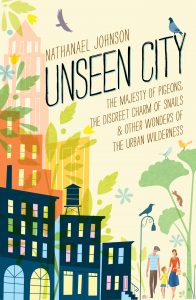Unseen City
Posted in From the Library on February 13 2017, by Esther Jackson
Esther Jackson is the Public Services Librarian at NYBG’s LuEsther T. Mertz Library where she manages Reference and Circulation services and oversees the Plant Information Office. She spends much of her time assisting researchers, providing instruction related to library resources, and collaborating with NYBG staff on various projects related to Garden initiatives and events.
 Unseen City: The majesty of pigeons, the discreet charm of snails & other wonders of the urban wilderness is Nathanael Johnson’s journal documenting the journey of teaching his daughter about the natural wonders of their home city, San Francisco. For me, the beginning of this book was what really shone. Johnson writes about his daughter’s habit as a toddler to ask “that?” when pointing at all number of objects in and features of her environment. In addition to identifying things like “house” or “sky,” Johnson found himself saying “tree” so frequently that he decided to change the way in which he replied to his daughter. He writes:
Unseen City: The majesty of pigeons, the discreet charm of snails & other wonders of the urban wilderness is Nathanael Johnson’s journal documenting the journey of teaching his daughter about the natural wonders of their home city, San Francisco. For me, the beginning of this book was what really shone. Johnson writes about his daughter’s habit as a toddler to ask “that?” when pointing at all number of objects in and features of her environment. In addition to identifying things like “house” or “sky,” Johnson found himself saying “tree” so frequently that he decided to change the way in which he replied to his daughter. He writes:
“I added a rule to complicate the game—I would give the same answer only once per outing. The second time Josephine inquired about a tree, I would have to be more specific. ‘Trunk,’ I would say, or leaves, a branch, a twig, a flower. And it was in this way that I noticed for the first time, though I’d walked by this tree hundreds of times, that it had tiny yellow flowers. The leaves were long and narrow, dark green on the top and, on the underside, nearly white, spotted with black. At the center of each cluster of leaves were tiny yellow flowers. I picked a few (a difficult task because breaking the supple green branch was like tearing a red licorice rope) and stuffed them in my pocket.”
Many fellow naturalists will see themselves reflected, to some extent, in this passage. Johnson and his daughter are curious explorers and hungry to understand more about the organisms in their environment. The real strength of Johnson’s book is how accessible he makes exploring one’s natural surroundings, even in a city. The section “Some Practical Recommendations for Neighborhood Naturalists” is spot on, and easy enough to follow with children.
The body of the book is comprised of Johnson’s essays about his exploration into various organisms. Chapter titles include, “Pigeon,” “Weeds,” “Squirrel,” “Bird Language,” “Gingko,” “Turkey Vulture,” “Ant,” “Crow,” and “Snail.” His style is similar to that of other popular science writers; each organism is discussed to the depth that he, as an amateur enthusiast, has reached an understanding. There is a list of cited literature at the end of the book, allowing readers to delve more deeply into study of the featured organisms, should they so wish.
For the most part, Johnson does an admirable job of making his chosen organisms interesting to the reader while bringing in scientific research to support his discussion. At some point, however, this amateur naturalist decided that focused non-academic study on select, unrelated organisms granted him license to make broad ecological judgments about topics such as invasive species management. Arriving at a section of the book titled, “In Defense of Invasion,” I knew I was in for disappointment. In spite of Johnson’s words to the contrary, non-native species are indeed a threat to native biodiversity. Challenges in invasive species management should and do prompt discussion about how we preserve native biodiversity while responsibly allocating useful resources to control or remove non-native plants. These challenges in invasive species management and control are a red herring that is too frequently used by science writers to undermine the importance of controlling invasive species. I would be more forgiving if Johnson displayed any depth of understanding on the topic, but his discussion on the topic is hardly that. Johnson misses the mark with his flippant and under-informed discourse on the topic, culminating with the statement “Naturalizing species have given us richer biodiversity.”
When looking at Unseen City as a whole, Johnson is to be commended for a stirring and informational nature journal. Having the chance to explore organisms through his words and through his daughter’s eyes allows for a moving and enjoyable reading experience. However, Johnson’s ill-informed and unbalanced treatment of invasive species management is cause for concern, and must be noted and criticized for its irresponsibility.

